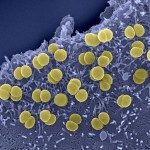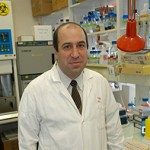Link to Pubmed [PMID] – 8830264
Mol. Microbiol. 1996 Mar;19(5):1073-84
Adherence to eukaryotic cells is essential in the pathogenesis of Neisseria meningitidis. Pilus-mediated adhesion has been shown to play an essential role in this process. Pilin, the pilus major subunit, and two pilus associated proteins, PilC1 and PilC2, are key components in meningococcal adhesiveness. Phase and/or antigenic variation of these molecules are the only identified means by which N. meningitidis modulates pilus-mediated adhesion. PilA/PilB is a pleiotropic regulatory system first characterized in Neisseria gonorrhoeae where it controls pilin gene transcription. Similar alleles are found in N. meningitidis. To address the role of this regulatory pathway in N. meningitidis, we engineered a meningococcal pilA mutant strain and analysed the consequences of this mutation on pilus-mediated adhesion using epithelial Hec-1-B cells. This mutation resulted in a threefold reduction in adhesiveness. As no change in the amount of pilin nor in pilin gene mRNA was detected, we compared the expression of the pilC genes in both pilA and parental strains. Two transcriptional fusions pilC1-lacZ and pilC2-lacZ were constructed. A threefold reduction in beta-galactosidase activity was observed in the pilA mutant strain harbouring the pilC1-lacZ fusion. No effect of the pilA mutation on beta-galactosidase activity was observed in the strain carrying the pilC2-lacZ fusion. Gel retardation experiments confirmed that the PilA protein binds to the promoter region of pilC1 but not of pilC2. Taken together, these data demonstrate that PilA modulates meningococcal adhesiveness via the transcription of pilC1. Thus, in addition to phase variation, a more co-ordinate and responsive system may allow a fine adaptation of adhesiveness of meningococci to various environmental signals.

